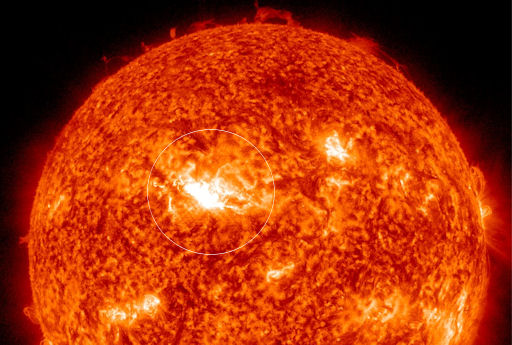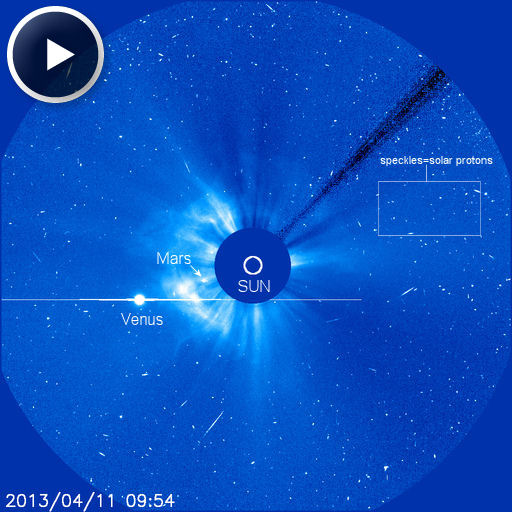http://spaceweather.com/
http://www.latimes.com/news/science/sciencenow/la-sci-sn-solar-flare-2013-20130411,0,1817542.story?track=rss
STRONG SOLAR FLARE: The magnetic field of sunspot AR1719 erupted on April 11th at 0716 UT, producing an M6-class solar flare. NASA's Solar Dynamics Observatory recorded the explosion's extreme ultraviolet flash:
Coronagraph images from the Solar and Heliospheric Observatory (SOHO) show a CME emerging from the blast site. The expanding cloud should hit Earth's magnetic field during the early hours of April 13th, possibly sparking geomagnetic storms and auroras. Aurora alerts: text, voice.
Click to play a movie of the CME recorded by (SOHO):
The speckles near the end of the movie are caused by energetic solar protons hitting the coronagraph's CCD detector; the particles were accelerated in the direction of the spacecraft by the flare.
Note that although the CME appears to hit Mars and Venus, there is no actual physical contact. The cloud is merely passing in front of the two planets. Stay tuned for updates about this significant explosion.
http://www.latimes.com/news/science/sciencenow/la-sci-sn-solar-flare-2013-20130411,0,1817542.story?track=rss
Massive solar eruption could cause magnetic storm here on Earth
CAPTIONS
Early Thursday morning, solar observers watched as a dark spot on the sun erupted with an enormous flash of light, causing the biggest solar flare of 2013.
Solar flares themselves don't last long, but this one was powerful enough to cause a bubble of solar material called a CME (coronal mass ejection) to come bursting off the sun.
Up to billions of tons of that solar material is now hurtling through space at the mind-bending speed of more than 600 miles per second, and it is heading directly toward Earth.
- The Biggest Day Coming?A wealthy businessman says a single day will soon change the US foreverwww.YouTube.com
- Specials on Mazda CX-9See special financing, incentives & lease offers on the Mazda CX-9.www.MazdaUSA.com
The CME will slow down a bit as it approaches our planet, and scientists expect it will reach the Earth's atmosphere late Friday night or early Saturday, but computer models can be off by up to seven hours either way, said NASA scientist Alex Young.
While a mass of solar material zooming toward Earth sounds kind of frightening, there's not much to worry about. CMEs can occasionally affect the electronic systems of satellites or the power grid here on the ground, but our atmosphere will protect us from any harmful radiation associated with the initial flare or the CME.
Plus, there's a major upside to these Earth-bound CMEs for sky watchers. When a CME interacts with the Earth's magnetosphere, it can cause geomagnetic storms and enhanced auroras that could be visible as far south as Michigan and New York.
Here in Southern California, we still won't be able to see them, but we'll look online for spectacular photos and videos of glowing green skies on the days after the CME hits.
Although Thursday morning's solar flare is the strongest to be recorded in 2013, NASA has classified it as a mid-level flare, and the agency notes that it was 10 times less powerful than the strongest flares, which are labeled X-class flares.
M-class flares are the weakest flares that can still cause effects on Earth. Thursday's solar flare was responsible for a brief radio blackout, NASA reported.
The sun is currently nearing the peak of its 11-year solar flare cycle, or what is known as solar max. At the peak of the cycle, it is normal for there to be several solar flares a day.
Young said we should expect more and larger solar flares toward the end of the year and the beginning of next year.


No comments:
Post a Comment